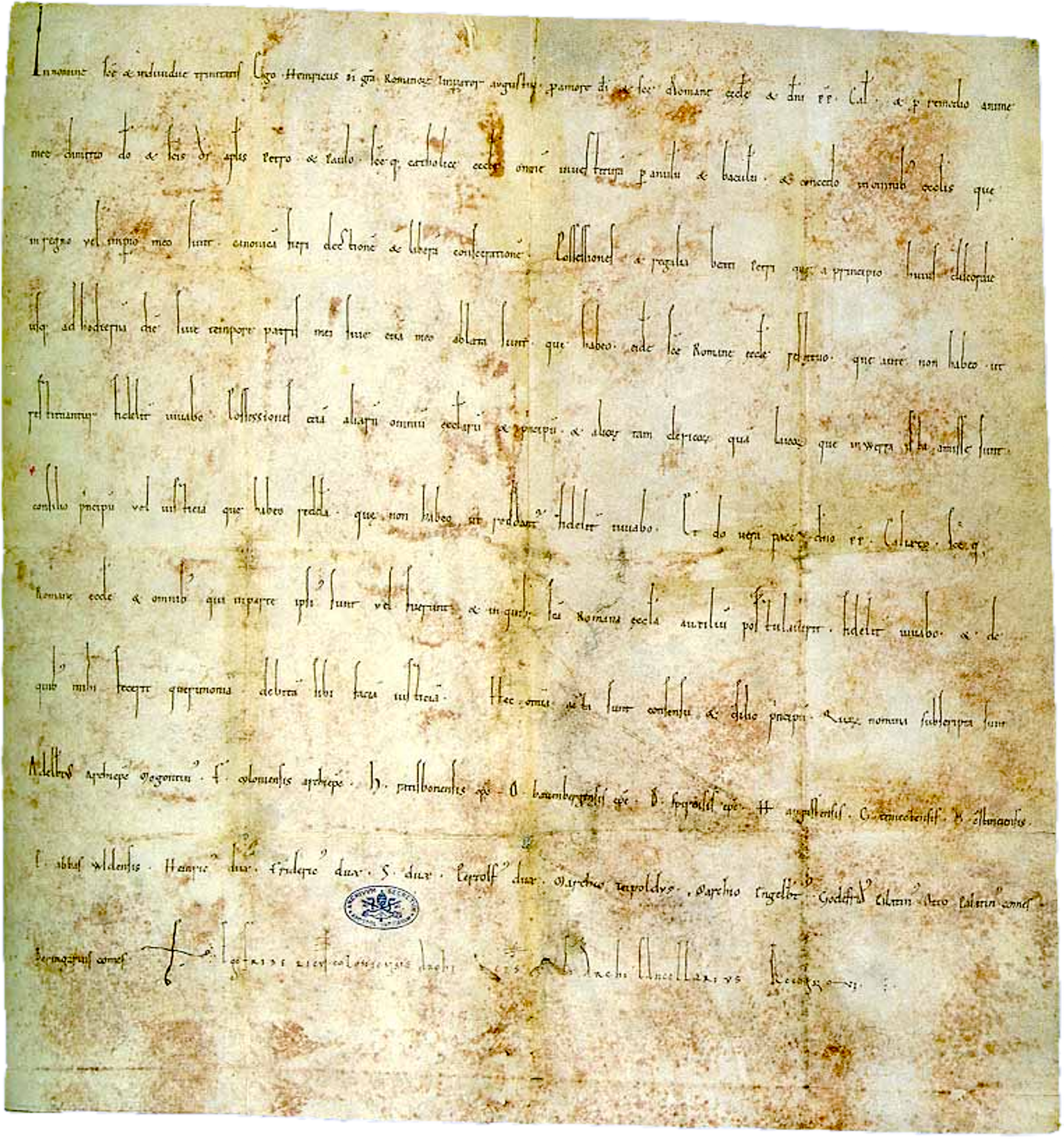|
Subinfeudation
In English law, subinfeudation is the practice by which tenants, holding land under the king or other superior lord, carved out new and distinct tenures in their turn by sub-letting or alienating a part of their lands. The tenants were termed mesne lords, with regard to those holding from them, the immediate tenant being ''tenant in capite''. The lowest tenant of all was the freeholder, or, as he was sometimes termed, ''tenant paravail''. The Crown, who in theory owned all lands, was '' lord paramount''. The great lords looked with dissatisfaction on the increase of such subtenures. Accordingly, in 1290 a statute was passed, , which allowed the tenant to alienate whenever he pleased, but the person to whom he granted the land was to hold it for the same immediate lord, and by the same services as the alienor held it before. Scotland In Scots law, the feudal system was abolished by the Abolition of Feudal Tenure etc. (Scotland) Act 2000. The length of a lease was limited t ... [...More Info...] [...Related Items...] OR: [Wikipedia] [Google] [Baidu] |
Statutes Of Mortmain
The Statutes of Mortmain were two enactments, in 1279 and 1290, passed in the reign of Edward I of England, aimed at preserving the kingdom's revenues by preventing land from passing into the possession of the Church. Possession of property by a corporation, such as the Church, was known as mortmain, which literally meant "dead hand". In medieval England, feudal estates generated taxes for the King (known as feudal ''incidents''), principally on the grant or inheritance of the estate. If an estate became owned by a religious corporation which could never die, could never attain majority, and could never be attainted for treason, these taxes never became payable. It was akin to the estates being owned by the dead, hence the term. The Statutes of Mortmain were meant to re-establish the prohibition against donating land to the Church for the purpose of avoiding feudal services, a prohibition which had originated in Magna Carta in 1215 and was specifically defined in its 1217 issue. ... [...More Info...] [...Related Items...] OR: [Wikipedia] [Google] [Baidu] |
Quia Emptores
''Quia Emptores'' is a statute passed by the Parliament of England in 1290 during the reign of Edward I that prevented tenants from alienating their lands to others by subinfeudation, instead requiring all tenants who wished to alienate their land to do so by substitution. The statute, along with its companion statute '' Quo Warranto'' also passed in 1290, was intended to remedy land ownership disputes and consequent financial difficulties that had resulted from the decline of the traditional feudal system in England during the High Middle Ages. The name ''Quia Emptores'' derives from the first two words of the statute in its original mediaeval Latin, which can be translated as "because the buyers". Its long title is A Statute of our Lord The King, concerning the Selling and Buying of Land. It is also cited as the Statute of Westminster III, one of many English and British statutes with that title. Prior to the passage of ''Quia Emptores'', tenants could either subinfeuda ... [...More Info...] [...Related Items...] OR: [Wikipedia] [Google] [Baidu] |
English Law
English law is the common law legal system of England and Wales, comprising mainly criminal law and civil law, each branch having its own courts and procedures. Principal elements of English law Although the common law has, historically, been the foundation and prime source of English law, the most authoritative law is statutory legislation, which comprises Acts of Parliament, regulations and by-laws. In the absence of any statutory law, the common law with its principle of ''stare decisis'' forms the residual source of law, based on judicial decisions, custom, and usage. Common law is made by sitting judges who apply both statutory law and established principles which are derived from the reasoning from earlier decisions. Equity is the other historic source of judge-made law. Common law can be amended or repealed by Parliament. Not being a civil law system, it has no comprehensive codification. However, most of its criminal law has been codified from its common ... [...More Info...] [...Related Items...] OR: [Wikipedia] [Google] [Baidu] |
Holy Roman Empire
The Holy Roman Empire was a political entity in Western, Central, and Southern Europe that developed during the Early Middle Ages and continued until its dissolution in 1806 during the Napoleonic Wars. From the accession of Otto I in 962 until the twelfth century, the Empire was the most powerful monarchy in Europe. Andrew Holt characterizes it as "perhaps the most powerful European state of the Middle Ages". The functioning of government depended on the harmonic cooperation (dubbed ''consensual rulership'' by Bernd Schneidmüller) between monarch and vassals but this harmony was disturbed during the Salian period. The empire reached the apex of territorial expansion and power under the House of Hohenstaufen in the mid-thirteenth century, but overextending led to partial collapse. On 25 December 800, Pope Leo III crowned the Frankish king Charlemagne as emperor, reviving the title in Western Europe, more than three centuries after the fall of the earlier ancient Western Ro ... [...More Info...] [...Related Items...] OR: [Wikipedia] [Google] [Baidu] |
Real Property Law
Property law is the area of law that governs the various forms of ownership in real property (land) and personal property. Property refers to legally protected claims to resources, such as land and personal property, including intellectual property. Property can be exchanged through contract law, and if property is violated, one could sue under tort law to protect it. The concept, idea or philosophy of property underlies all property law. In some jurisdictions, historically all property was owned by the monarch and it devolved through feudal land tenure or other feudal systems of loyalty and fealty. History Though the Napoleonic code was among the first government acts of modern times to introduce the notion of absolute ownership into statute, protection of personal property rights was present in medieval Islamic law and jurisprudence, and in more feudalist forms in the common law courts of medieval and early modern England. Theory The word ''property'', in everyday usag ... [...More Info...] [...Related Items...] OR: [Wikipedia] [Google] [Baidu] |
Concordat Of Worms
The Concordat of Worms(; ) was an agreement between the Catholic Church and the Holy Roman Empire which regulated the procedure for the appointment of bishops and abbots in the Empire. Signed on 23 September 1122 in the German city of Worms by Pope Callixtus II and Emperor Henry V, the agreement set an end to the Investiture Controversy, a conflict between state and church over the right to appoint religious office holders that had begun in the middle of the 11th century. By signing the concordat, Henry renounced his right to invest bishops and abbots with ring and crosier, and opened ecclesiastical appointments in his realm to canonical elections. Callixtus, in turn, agreed to the presence of the emperor or his officials at the elections and granted the emperor the right to intervene in the case of disputed outcomes. The emperor was also allowed to perform a separate ceremony in which he would invest bishops and abbots with a sceptre, representing the imperial lands assoc ... [...More Info...] [...Related Items...] OR: [Wikipedia] [Google] [Baidu] |
Charter Of Liberties
The Charter of Liberties, also called the Coronation Charter, or Statutes of the Realm, was a written proclamation by Henry I of England, issued upon his accession to the throne in 1100. It sought to bind the King to certain laws regarding the treatment of nobles, church officials, and individuals. The nineteenth-century historians Frederick Maitland and Frederick Pollock considered it a landmark document in English legal history and a forerunner of Magna Carta. The document addressed abuses of royal power by his predecessor William II (his brother William Rufus), as perceived by the nobility, specifically the over-taxation of the barons, the abuse of vacant sees, and the practices of simony and pluralism. The Charter of Liberties was generally ignored by monarchs, until in 1213 Stephen Langton, Archbishop of Canterbury, reminded the nobles that their liberties had been guaranteed over a century prior in Henry I's Charter of Liberties. Background Henry I of England, ni ... [...More Info...] [...Related Items...] OR: [Wikipedia] [Google] [Baidu] |
Afterlehen
An ''Afterlehen'' or ''Afterlehn'' ''(plural: Afterlehne, Afterlehen)'' is a fief that the liege lord has himself been given as a fief and has then, in turn, enfeoffed it wholly or partially to a lesser vassal or vassals. The term is German. It is variously referred to in English as a mesne-fiefFahrenkrüger (1801), 2nd Part, p. 26. Retrieved 11 May 201(in German-English)/ref> or mesne-tenure, an arriere-fief or subfief, under-tenure or mesnalty. Within the Holy Roman Empire these mesne fiefs even became inheritable over time and could have up to five "stations" between the actual holder of the fief and the overarching liege lord. [...More Info...] [...Related Items...] OR: [Wikipedia] [Google] [Baidu] |
Abolition Of Feudal Tenure Etc
Abolition refers to the act of putting an end to something by law, and may refer to: *Abolitionism, abolition of slavery *Abolition of the death penalty, also called capital punishment *Abolition of monarchy The abolition of monarchy and anti-royalism is a legislative or revolutionary movement to abolish monarchical elements in government, usually hereditary. Abolition of absolutist monarchy in favor of limited government under constitutional mon ... * Abolition of nuclear weapons * Abolition of prisons * Police abolition movement * Abolition of suffering * Abolitionism (animal rights), related to veganism * Abolition of time zones * Abolition of borders See also * * Abolition of slavery timeline * Abolitionism (other) {{disambiguation ... [...More Info...] [...Related Items...] OR: [Wikipedia] [Google] [Baidu] |
Lease
A lease is a contractual arrangement calling for the user (referred to as the ''lessee'') to pay the owner (referred to as the ''lessor'') for the use of an asset. Property, buildings and vehicles are common assets that are leased. Industrial or business equipment are also leased. Basically a lease agreement is a contract between two parties: the lessor and the lessee. The lessor is the legal owner of the asset, while the lessee obtains the right to use the asset in return for regular rental payments. The lessee also agrees to abide by various conditions regarding their use of the property or equipment. For example, a person leasing a car may agree to the condition that the car will only be used for personal use. The term rental agreement can refer to two kinds of leases: * A lease in which the asset is tangible property. Here, the user '' rents'' the asset (e.g. land or goods) ''let out'' or ''rented out'' by the owner (the verb ''to lease'' is less precise because it can ... [...More Info...] [...Related Items...] OR: [Wikipedia] [Google] [Baidu] |
Tenement (law)
{{Wiktionary, tenement A tenement (from the Latin tenere ''to hold''), in law, is anything that is held, rather than owned. This usage is a holdover from feudalism, which still forms the basis of property law in many common law jurisdictions, in which the monarch alone owned the allodial title to all the land within his kingdom. Under feudalism, land itself was never privately "owned" but rather was "held" by a tenant (from Latin ''teneo'' "to hold") as a fee, being merely a legal right over land known in modern law as an estate in land. This was held from a superior overlord, (a mesne lord), or from the crown itself in which case the holder was termed a tenant-in-chief, upon some manner of service under one of a variety of feudal land tenures. The thing held is called a tenement, the holder is called a tenant, the manner of his holding is called a tenure, and the superior is called the landlord, or lord of the fee. These forms are still preserved in law, even though feud ... [...More Info...] [...Related Items...] OR: [Wikipedia] [Google] [Baidu] |
%2C_original_Latin.png)



